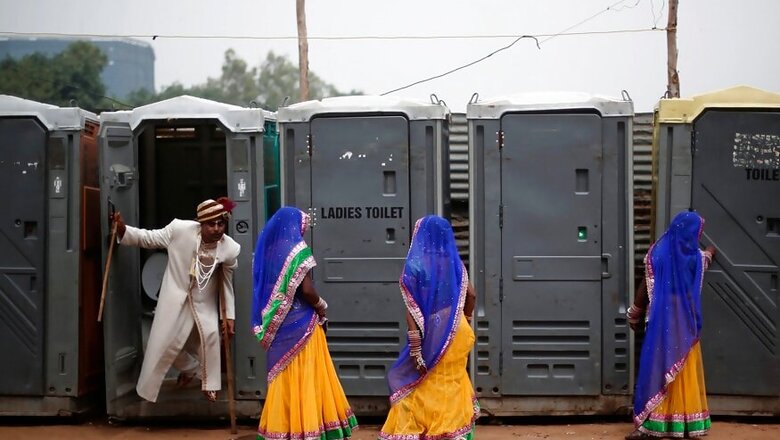
views
When 34-year-old Mursida Khatun, a resident of Mohammadpur Badal village in Bihar, constructed a toilet in her home in 2016, she hoped it would solve her problems. Her young daughter was getting married that year, and her son was expected to get married soon as well. A toilet would add “glamour” to the wedding, she recalled.
“The Swachh Bharat Mission (SBM) propagated that toilets are important for our health and well-being. They said it is our right. So, we collected funds to construct a toilet in our home at the earliest,” she said. The guests attending the wedding did not have to go out to the fields.
The family of six had gotten a twin pit toilet made for themselves under the government’s flagship scheme on sanitation. That toilet is in its fourth year of use.
However, four years later, it has dumped an unprecedented economic burden on Mursida – all because she didn’t know what to do with the faecal matter piling up inside a pit with no outlet.
In June 2019, when Mursida’s son was getting married, the pit was well beyond half its capacity to store faecal sludge. The design of the toilet, recommended by Jal Shakti Ministry, provided for faecal sludge to be converted into natural manure in a year’s time. But, two weddings later, the pit was full and had to be emptied.
“There were many guests. But hardly any manure,” she said, bursting into laughter.
Under a sense of urgency, for the cause of health and wellbeing, Mursida contacted a sludge machine operator to clean the pit and suck out all faecal matter. “He demanded Rs 2,000 to empty half the pit,” she said.
Spending one-fourth of the entire household income into cleaning toilets is an expenditure the family had never anticipated. But, given that they had been using it for years now, and were accustomed to the new practice, the expenditure seemed legitimate.
“My husband is the only earning member in the family. He is a daily wage labourer and earns Rs 7,000-8,000 a month. We would have used the manure had there been any. Instead, we are having to spend money to clean it,” she said.
“Did the wedding guests enjoy themselves a little too much?” she wondered.
Managing Faecal Sludge
On October 2, 2019, India’s declaration to the world that its villages are open defecation free (ODF) only solves one of two problems. The fact that the country’s sanitation coverage has doubled, if not scaled 100 per cent as claimed by the government, in itself is an achievement not many would have lived to see.
However, what this mass campaign on toilet construction – more than 10 crore – also created is a bulk of faecal sludge in tanks and pits across the country. Managing and disposing this sludge is the next challenge to sustain the ODF status.
To tackle this, on September 27, 2019 the government launched a 10-year national rural sanitation strategy to sustain India’s 100 per cent ODF status. Key components of this strategy are the ODF-plus and ODF-plus-plus missions – both of which focus on the proper implementation of solid, liquid waste and faecal sludge management in rural areas.
At the launch of the scheme, the Centre had provided guidelines for the construction of individual household latrines (IHHL). It said that a complete IIHL must include a sanitary substructure to confine faecal sludge, a super structure and a facility for water storage. Although the Jal Shakti recognised safe sanitation technologies like the septic tank with soak pit, eco-san and bio-toilets, it encouraged the use of twin-pit technology because it is low-cost, easy to build and consumes less water.
Furthermore, the twin-pit technology also enables a household to convert sludge into natural manure over the course of a year. Divyang Waghela, head of the Tata Water Mission, believes the twin-pit is India's best bet today.
"This technology is easy to install and simple to adopt and can be managed quite easily by users. Going forward, India needs to work on mechanisms to address second generation issues that are simple, low maintenance, affordable and geographically best-suited,” he said.
But, what was essentially missed at the time was taken care of later – five years later under the Fecal Sludge Management (FSM) component of ODF-plus.
“The first target was to have toilets in all households. We were not told that the faecal disposal was also to be managed. When we introduced the twin-pit in 2016, talk around faecal sludge was completely done away with because these toilets decomposed it. Faecal sludge occurs only in septic tanks. Nobody knew about faecal sludge before this. Everyone has woken up to this problem after five years,” said an official at the ministry, on condition of anonymity.
As per an advisory by the ministry, the management of sludge essentially undergoes a process that comprises five stages: containment, desludging, transport, treatment and reuse/disposal. Treatment, more than any other stage, is a cause for concern in the country as states are not equipped with enough sewage treatment plants (STP).
Measures to manage sludge under ODF-plus also include the retrofitting of single-pit toilets to twin-pits or making provision to empty pits every five years, repairing defunct toilets and the construction of soak pits for septic tanks.
Nevertheless, for those like Mursida, safe disposal of sludge became an unprecedented and unanticipated problem sooner than later.
Why Manage Faecal Sludge
While planning the construction of a toilet at home years ago, Pawan Singh, the pradhan of Nizampur village in Uttarakhand, asked the mason to build three tanks to collect faecal sludge for his family of five.
“In the first tank, the sludge deposits itself. Via a connecting pipe the sludge then transfers itself to another tank after a certain level. In the third tank, the leftover sludge deposits and the residue water after treatment is drained out,” he said.
However, not everyone is as economically comfortable or foresighted as Pawan Singh. His brother, who did not have a toilet earlier and constructed one under the SBM in 2018, only managed to make a septic tank, from where black water is drained out to an irrigating canal.
The issue with both twin-pit and septic tank-based toilets is more than what meets the eye. Jay Prakash, head of the water, sanitation and hygiene division at the Agha Khan Rural Support Program in Bihar shared his experiences of twin-pit toilets in northern Bihar.
“Because of the high water table, poorly constructed, deep dug toilets may contaminate water at times. The given dimension of 1 metre in diameter and 3.5 ft depth is hardly followed. Rural communities believe that small pits will fill sooner and thus, dig deeper ones,” he said.
Here, the Tata Water Mission's head noted the health problems associated with groundwater contamination. He said faecal sludge when mixed with water causes "serious health effects such as hepatitis and dysentery".
Faecal sludge in twin-pit toilets poses a different problem in north east India. “Along the floodplains of Brahmaputra, people open the lids of their pits when the flood water rushes in. They think that the flood will clean the pits and carry the sludge with them. These habits take a lot of time and persistence to change, but are necessary because it contaminates surface water,” said a Zilla Swachh Bharat Prerak from north east, on condition of anonymity.
In addition, the discharge of septic tanks or black water, which according to the National Annual Rural Sanitation Survey 2018-19 exists in more than 70 per cent households, are thrown out into drains.
This faecal matter needs to be stored, treated and disposed, but Patna has only four sewage treatment plants; the whole of UP has only 18, added Jay Prakash, suggesting a lack of treatment facility infrastructure in the country.
Incentivising Faecal Sludge Management
Although, India’s rural sanitation programme was first introduced in 1954 as part of the first five year plan, coverage could only reach 1 per cent by the 1981 census. In 1999, rural sanitation received a new impetus under the Total Sanitation Campaign. This time the focus was more on information, education & communication, human resource development and capacity-building.
A result of this renewed push was the Nirmal Bharat Abhiyan (NBA), the predecessor of the SBM launched in 2012. The goal under NBA was to increase rural sanitation coverage via incentivising toilet construction – a model adopted by the SBM with added emphasis on information, education & communication.
According to Waghela, information, education & communication "is an important component of the SBM towards universal sanitation and making India ODF. It has focused on changing the mindset of the people and promoting adoption of improved hygiene practices".
While there is no doubt that access to toilet has tremendously increased over the past five years under the SBM vis-à-vis other similar schemes, faecal sludge management is something the government has renewed its push on only recently. However, five years later, at the receiving end of this gap in a comprehensive sanitation policy are also people like Raksha Nagar, a resident of Debi Khera village in Madhya Pradesh.
Unlike Mursida, 26-year-old Raksha, Swachhagrahi of her village, lives in a drought-prone area with her family of eight. “I borrowed money from my parents to construct a toilet under the SBM. The toilet has been made, but I still haven’t received money from the government,” she said.
Swachharahis are the dedicated, trained and properly incentivised sanitation workforce or foot soldiers at the village level – the least credited persons in making the India’s open defecation free. While their task at the end of five years is nearly complete, the ministry under the ODF-plus mission may have newer responsibilities for them.
The ODF-plus guidelines have also incentivised the management of faeces. According to an advisory by the ministry, people can plan establishing new rural sewage treatment plants by determining the business model, identifying revenue source and determining operational cost. The Swachhagrahis, officials at the ministry said, have a role to play in this.
The toilet in Raksha’s home is a septic tank-based toilet. The sludge is collected in a tank. But the water draining out of it is used in their farm behind the house.
“Using contaminated water causes us a lot of problems like diarrhoea, malaria, fever, skin rashes. Once a woman was crossing a drain that had dirty water; it was black water. She couldn't see anything below and cut her feet as a result,” she said, adding “But where will all the shit go?”
“Presently, there are no mechanisms to dispose the sludge. I hear the government has planned this in the next phase of the mission. I am ready to contribute my bit again.”
“Will they actually build plants to treat faeces in Chhattarpur district?” she wondered.



















Comments
0 comment